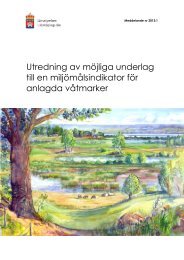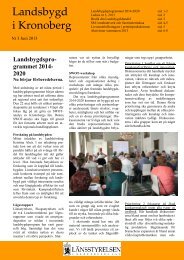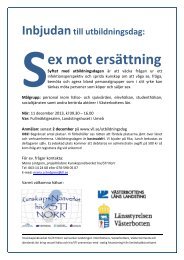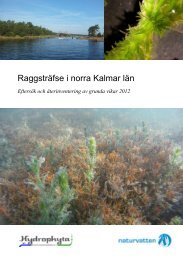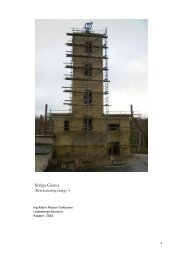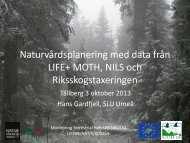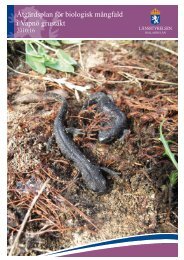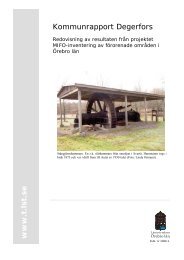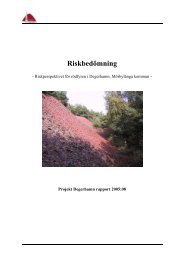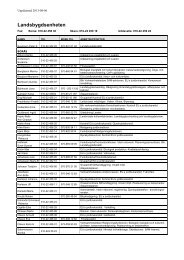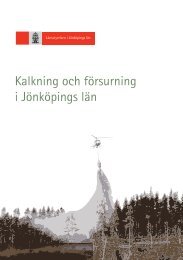Gillöga och Lilla Nassa - Länsstyrelserna
Gillöga och Lilla Nassa - Länsstyrelserna
Gillöga och Lilla Nassa - Länsstyrelserna
You also want an ePaper? Increase the reach of your titles
YUMPU automatically turns print PDFs into web optimized ePapers that Google loves.
Summary<br />
Stora <strong>Nassa</strong> – Svenska Högarna is one of four BSPAs (Baltic Sea Protected<br />
Area) in the Stockholm county. The BSPAs is one result of agreements<br />
between the Baltic Sea countries concerning the environmental work in the<br />
Baltic Sea. The agreements include biological diversity and the BSPA-areas<br />
are meant to protect representative networks of marine habitats. Earlier<br />
studies in the BSPA include marine biological surveys in the two nature<br />
reserves of Stora <strong>Nassa</strong> and Svenska Högarna.<br />
In June 2008 Sveriges Vattenekologer AB assigned by the County<br />
Administrative Board of Stockholm performed a marine biological survey<br />
of the aquatic communities and carried out a habitat value evaluation of the<br />
shallow bottoms around <strong>Gillöga</strong> – <strong>Lilla</strong> <strong>Nassa</strong>. The aim of the investigation<br />
was to describe the vegetation and fish communities in the area and evaluate<br />
the habitat values.<br />
Benthic communities between 0 and 10 m depth were investigated with line<br />
transects, quantitative samples and a test fishing study. The 12 line transects<br />
were assessed by scuba divers and describes the species composition, cover<br />
and depth extension of the benthic flora. Three quantitative frame samples<br />
were taken on three of the line transects in order to estimate the abundance<br />
of fauna within the plant community. In order to describe the fish<br />
community in the area, a test fishing study was performed.<br />
The habitat value analysis was based on the following aspects:<br />
• Species richness & variation – The number of species observed in the<br />
area was normal with regard to macroalgal communities, including its<br />
fauna, and the fish community. The area included all types of substrate,<br />
often with different levels of wave-exposure, which contributed to a<br />
varied species composition in the macroalgal communities. The vascular<br />
plant communities were, as expected, both sparse and species poor.<br />
• Rareness / Rarity –Three of the observed species, eelpout (Zoarces<br />
viviparus), turbot (Psetta maximus) and cod (Gadus morhua) are listed<br />
on the endangered species list. Eelpout and turbot are listed as near<br />
threatened, whereas cod is considered to be endangered.<br />
• Intactness – The area was generally unexploited. The few noticable<br />
traces of human activity on the shore and sea floor included some<br />
buildings and piers.<br />
• Representativity – The area represents sheltered areas in an outer<br />
archipelago, thus less influenced by for example run-off from the<br />
mainland than inner archipelago areas. The area included both more<br />
wave-exposed bottoms typical for the outer archipelago as well as more<br />
9



